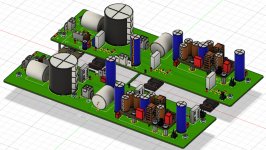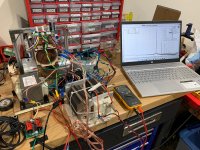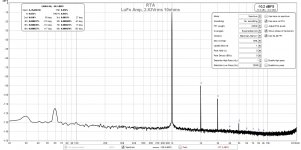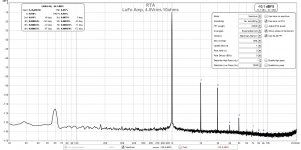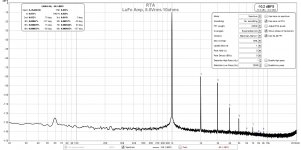I left the LuFo on all day yesterday...Returned to listen after 18 hrs of burn in. The sound is just better. Smoother. Fluidly dynamic. It’s only in mono and I can say it’s one of the best amps I have heard. Makes you want to listen more and stay longer.
Nice! That's a big statement right there.
Best,
Anand.
Looking forward to what Toroidy say...
I sent Tomasz a detailed e-mail yesterday evening...will post here with his reply.
Best,
Anand.
In anticipation for this upcoming build, I used my Peak LCR45 meter to test 5 md-803amr MOT’s in my stash:
0R57, 51.85mH
0R54, 47.70mH
0R57, 59.64mH
0R55, 54.10mH
0R90, 7.90mH *BAD*
Looks like the DCR is very consistent, but the inductance varies +/-6mh from the average. Doesn’t seem too bad, unless you have the 47mH and 59mH as a pair.

Vunce/X,
I would be curious to know how much the inductance varies with 3A of current running through the choke.
I am sure a test setup can get expensive and that is what big transformer companies have to do to check for saturation.
In our little diy world, perhaps the easiest way is to build the amp but try multiple different chokes with varying inductance values and then evaluate how that affects peak to peak swing at the output, frequency response (especially -3dB at the low end), etc...
I figure 50-75 mH minimum is the goal for decent bass response.
Best,
Anand.
Last edited:
I think a measure of frequency response into a dummy load at higher power is most practical way to check if the inductance is enough. I have had enough time to listen subjectively and can say that I don’t hear anything wrong or bad or off. Even the turn on and off behavior with a cap Mx PSU is devoid of thumps or pops. The inductor input voltage (the JFET source) rises slowly to about 1.5v over maybe 5 to 7 seconds so a gradual turn on.
The amp is absolutely silent with no music playing. With ear pressed to speaker cone, cannot tell it is on. No hiss no hum no sound. About as quiet as the Lottery VFET amp.
The amp is absolutely silent with no music playing. With ear pressed to speaker cone, cannot tell it is on. No hiss no hum no sound. About as quiet as the Lottery VFET amp.
These MOT's are easy to take apart with a little hacksaw. Remove the unused secondary.
Wind full of wire that can stan the current, and if the R is to high (please calculate before)
use less turns of thicker wire. An you can vary the airgap to play with inductance or saturation.
Wind full of wire that can stan the current, and if the R is to high (please calculate before)
use less turns of thicker wire. An you can vary the airgap to play with inductance or saturation.
When I get mine built, I can definitely do a Bode Plot analysis using my 'scope and get some results. Should be fun.
Thanks X!
Best,
Anand.
Thanks X!
Best,
Anand.
A frequency sweepusing REW will get yout the freqeuncy response as well as the variation of harmonics vs frequency.
Howto - Distortion Measurements with REW
Wtnh made a very nice diagram to show how to set this up (any sound interface with balanced input can work here - I typically use Focusrite 2i2 or 2i4):
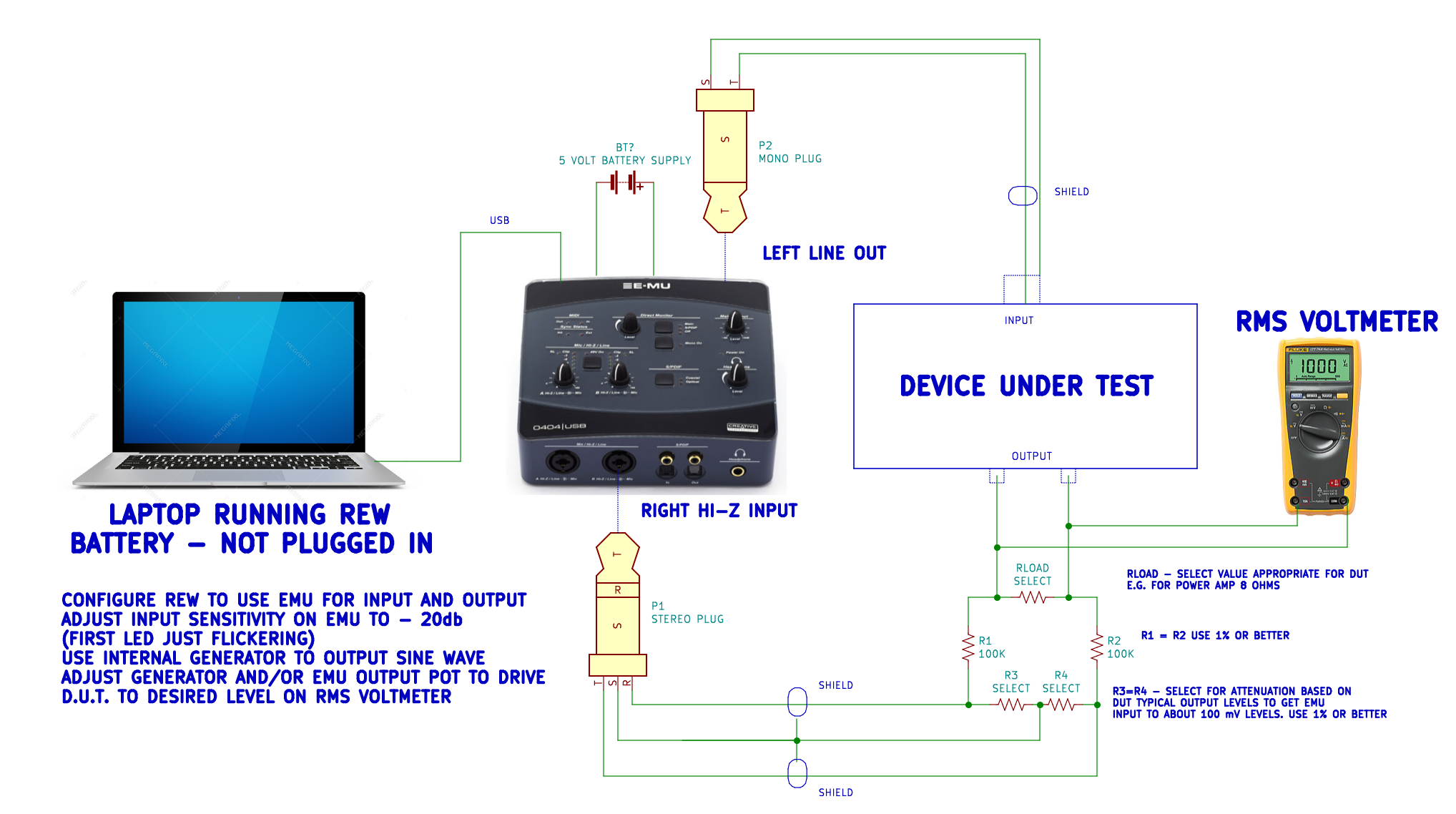
Here is a distortion/amplitude vs frequency sweep of the Focusrite in loopback mode:

Howto - Distortion Measurements with REW
Wtnh made a very nice diagram to show how to set this up (any sound interface with balanced input can work here - I typically use Focusrite 2i2 or 2i4):
Here is a distortion/amplitude vs frequency sweep of the Focusrite in loopback mode:
Last edited:
JPS64 has made some nice progress - here is the schematic and layout so far. If anyone has questions or comments/suggestions, please don't hesistate to ask. This is designed for use on a DIYA Store UMS comaptible heatsink for easy mounting.
We have made provisions for the optional M2X/Yarra format front end board mounting bolts. This will require you to use a separate power supply (to be provided by user). Or you can just use it as a 0dB gain amp like a MoFo or an F4. We also have optional connectors or direct solder flying leads for those who prefer that.
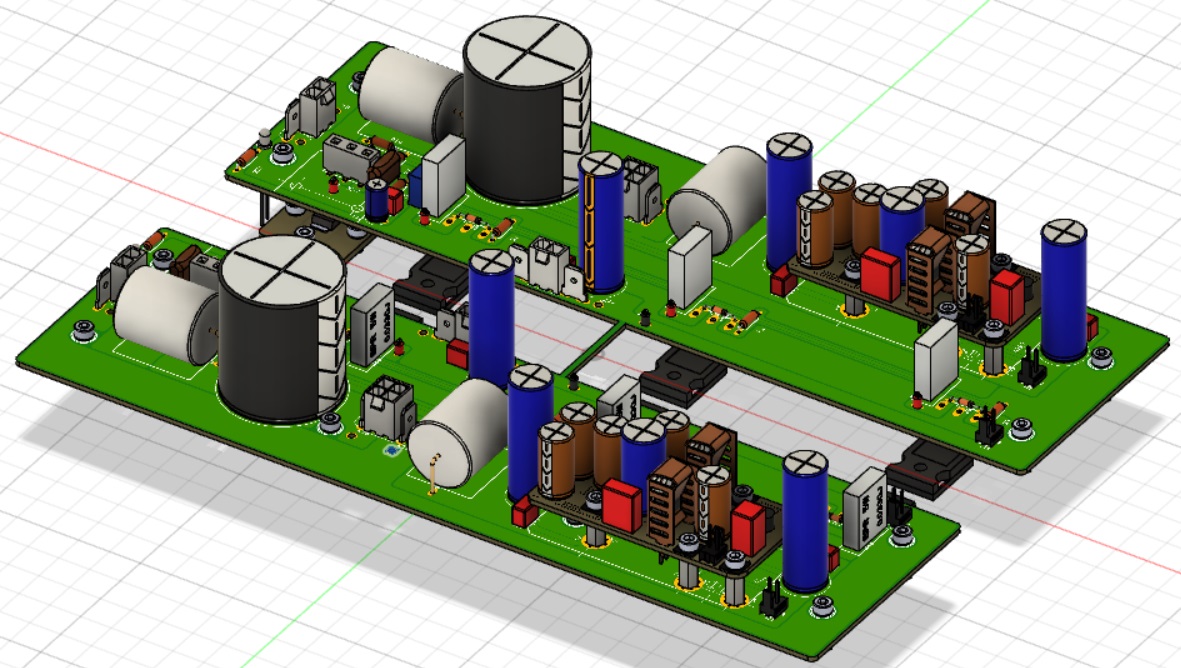
The rev 0a (initial) schematic is attached below as PDF.
Thank you, JPS64! Another beautiful, symmetric looking layout.
We have made provisions for the optional M2X/Yarra format front end board mounting bolts. This will require you to use a separate power supply (to be provided by user). Or you can just use it as a 0dB gain amp like a MoFo or an F4. We also have optional connectors or direct solder flying leads for those who prefer that.
The rev 0a (initial) schematic is attached below as PDF.
Thank you, JPS64! Another beautiful, symmetric looking layout.
Attachments
If you were using a ~24V rails for this amp, couldn't you use the same power supply for the M2x/Yarra boards?
Yes, but the amp has no Edcor voltage boost autoformer, so the standard M2X boards don't have gain as they are unity buffers. You can make your own front end with gain, using that footprint though or get ready made ones that do have gain already. Something at least 22dB to 28dB is recommended.
Did the big Hammond 195T5 get dismissed? It's ~$3.00 more expensive than the 193V when I checked just now. Just thinking out loud... I seem to recall seeing those on a couple of Big MoFo builds.
That Hammond 195T10 has nice specs that read like a MOT. 10A, 0.42ohm DCR, 100mH. I requested a custom choke once with similar specs and it was $350ea. The 195T10 is $300ea at $600/amp that’s some investment. The 35lbs almost guarantees it will be a monoblock.
Once I have a chance to listen to an amp subjectively for several days, and I can hear all the things I like or don't like about it, I will then take measurements. The reason I do it this way is so I do not bias my subjective opinion with the data. As I said before, this amp sounds so good - perhaps one of the best amps I have heard. That usually means that it has very low noise, a good 2nd order dominant harmonic profile, and monotonically descending higher orders. It also means that usually, the third harmonic is about -10 to 15dB lower than the second harmonic, and there is very little of higher orders beyond 3rd or 4th at lower powers.
The measurement setup is same as I have used many times in the past: Focusrite 2i4 sound interface operating in ASIO mode, REW software, 10ohm non inductive EBG 300w thin film resistor, and balanced 10:1 signal attenutator for the inputs. This time, since this amp is not an ultra-low distortion amp, I used simply a 1kHz test tone FLAC file played by a high quality digital player (Cayin N3 with AKM4490 DAC). Fluke 101 meter to measure the RMS voltage. I am using the Aksa Lender as the preamp here to get some gain to drive the amp.
Photo of the setup, you can see the heatsinked dummy load resistor in the foreground and the balanced signal attenuator with the two 4.7uF 250v MKP film caps to couple the signal to the audio interface.
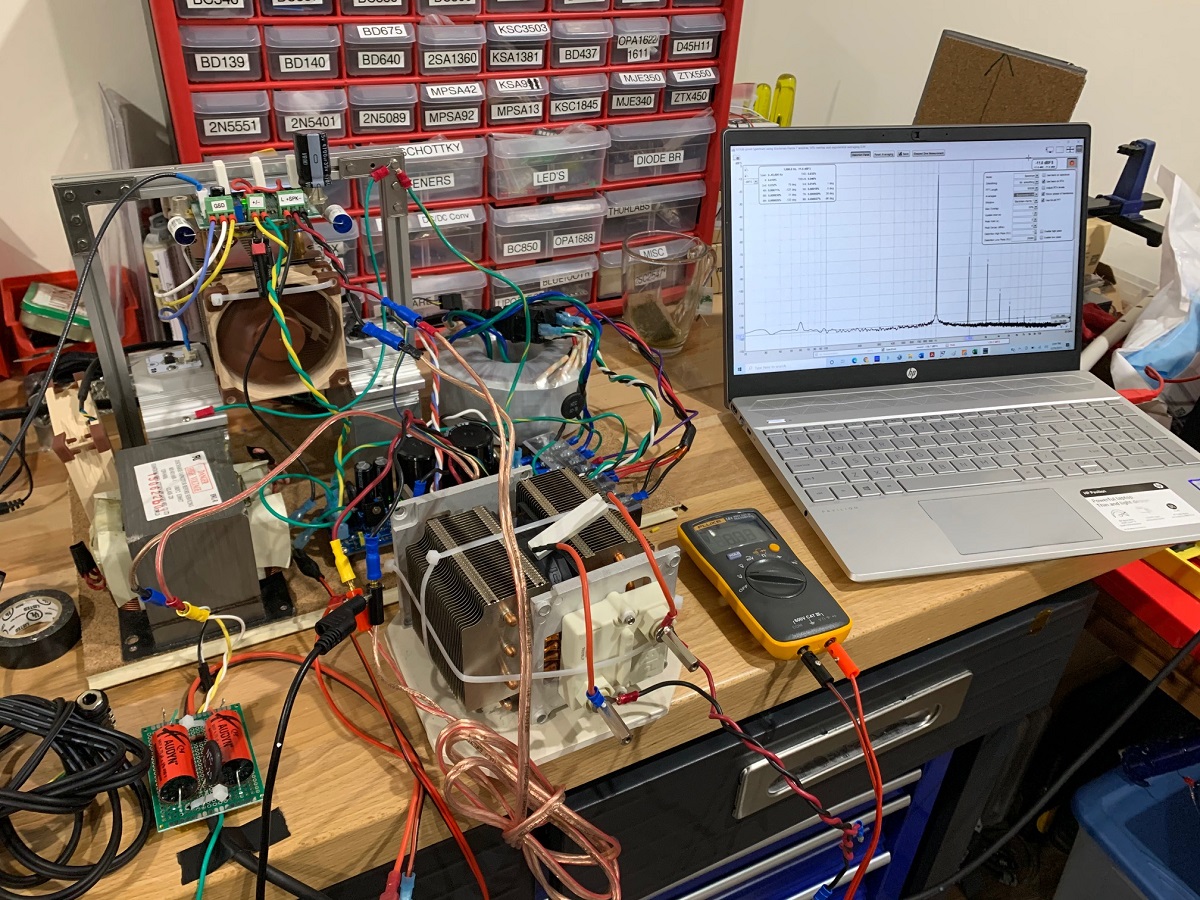
Here is 2.83Vrms into 10ohms - we get 0.010% THD and a harmonic profile very similar to predicted for 8ohms. There is a small bump at the 5th harmonic, although very low - this might be a problem at higher powers if it becomes too high. We will keep an eye on it. The noise floor is very low circa -125dB (not including the 60Hx bump) and clean and free of hash. There is a 60Hz bump, but I believe that is just pickup from the EMI in the air. It is still down at -105dB:
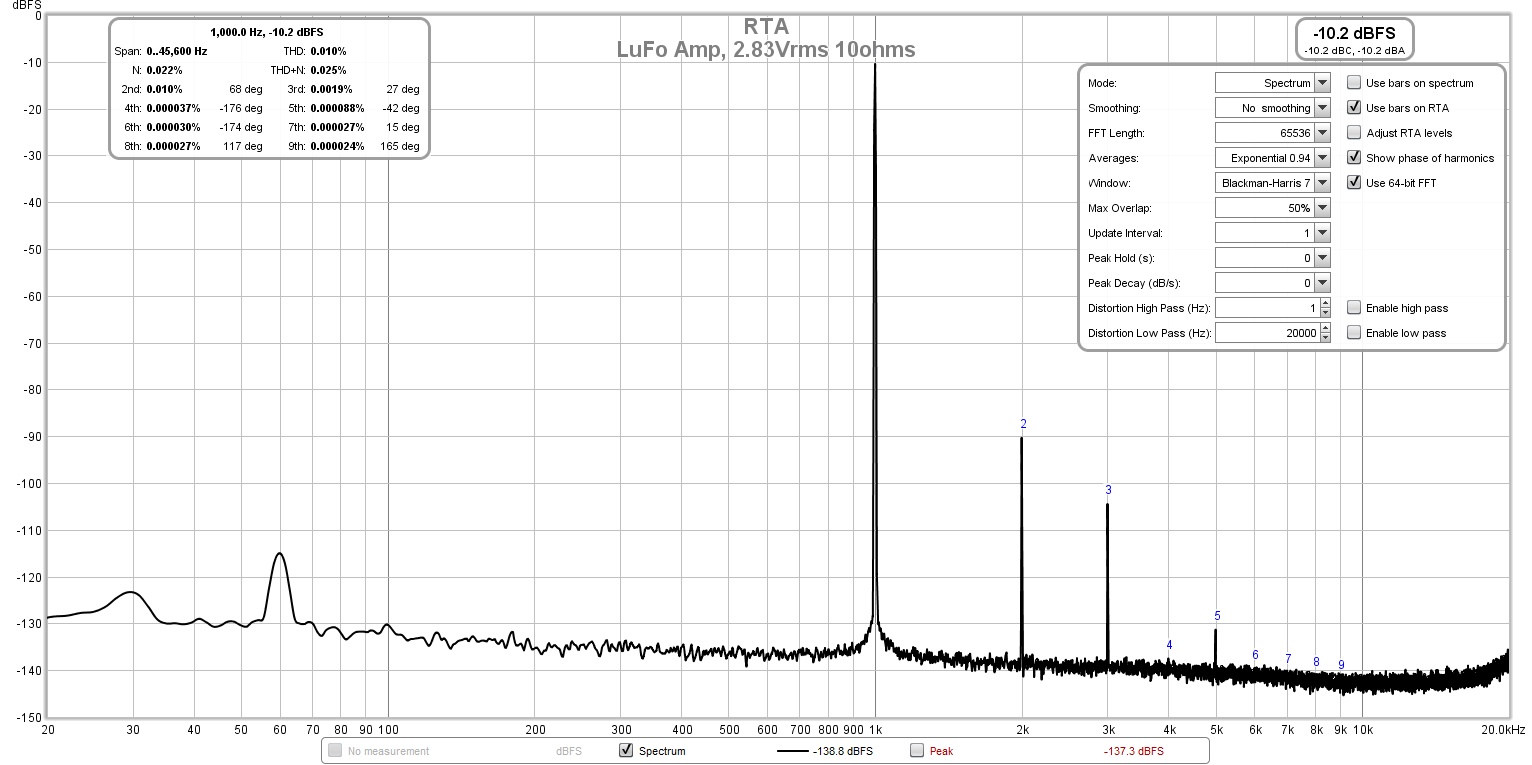
Here is 4.0Vrms into 10ohms - we get 0.017% THD:
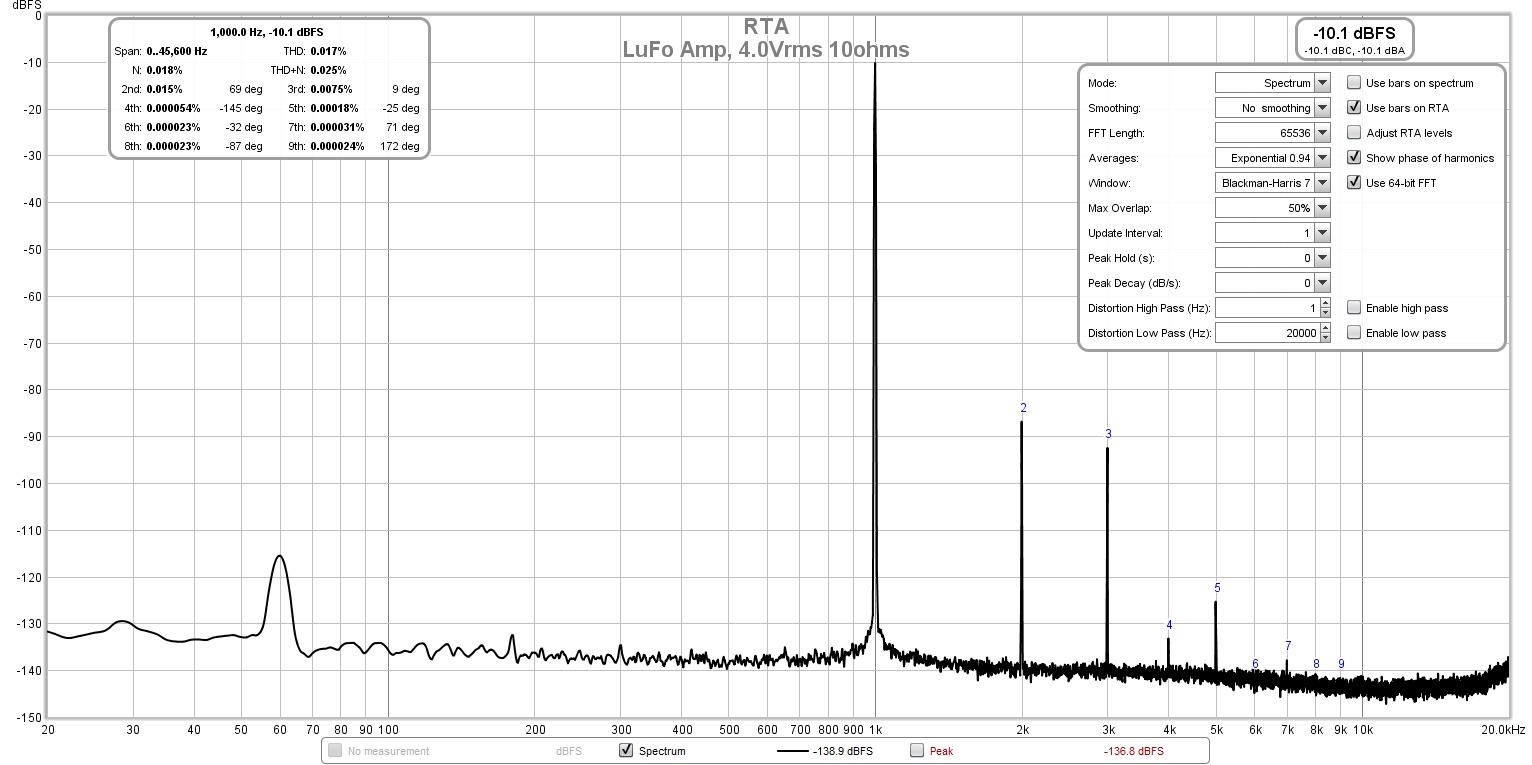
Here is 8.0Vrms into 10ohms (a quite loud playing level for average music), 0.035% THD and still a dominant second harmonic and lower higher orders. The 5th harmonic here is not a problem as it is just part of a progression of decreasing higher orders harmonics:
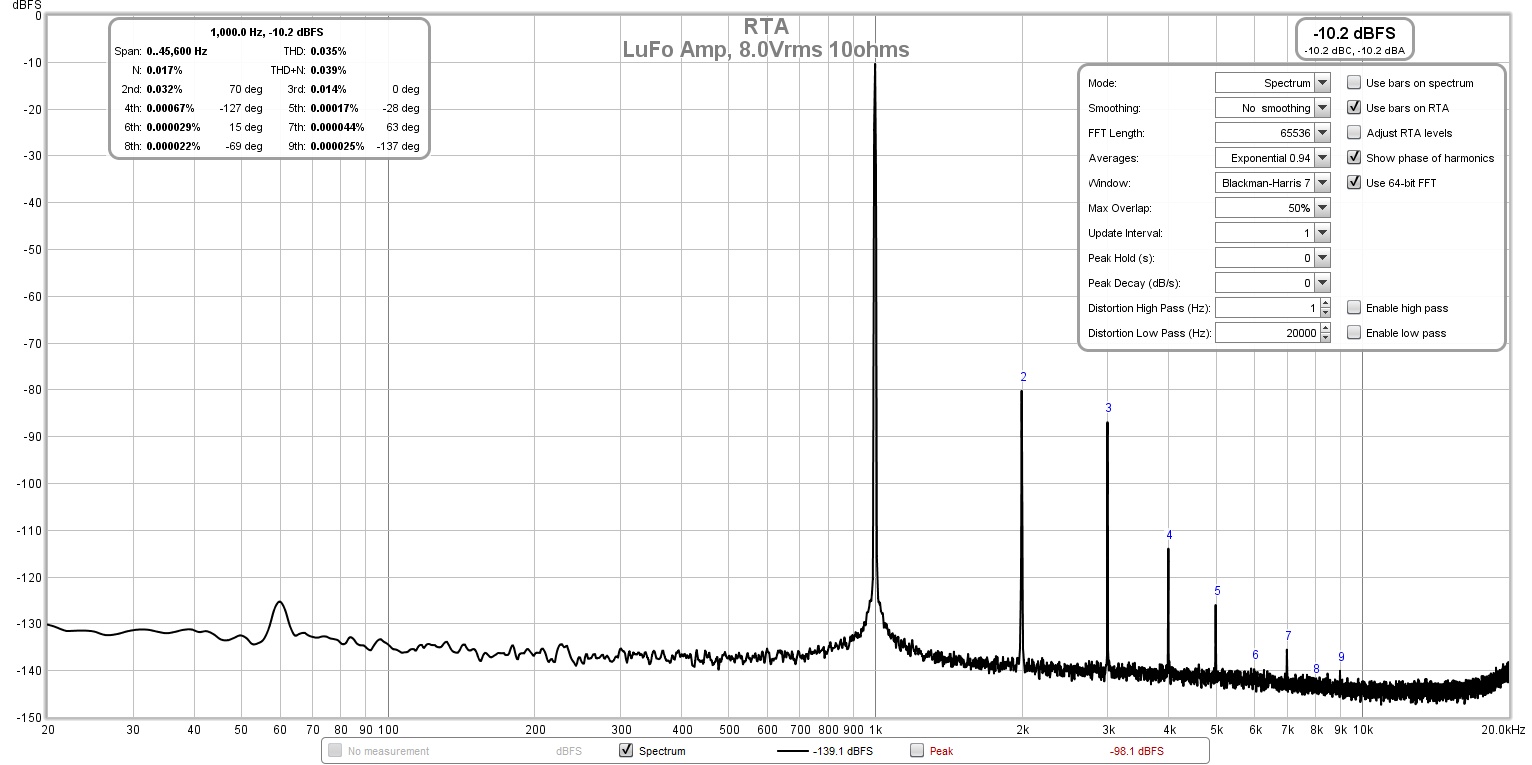
This amp measures very well. At this point, I could not do higher powers as my signal generator and preamp combo were not set up for it. So far, it is behaving very closely to the simulation. Looks like the grounding and the choice of PSU made for a very quiet amp as well.
The measurement setup is same as I have used many times in the past: Focusrite 2i4 sound interface operating in ASIO mode, REW software, 10ohm non inductive EBG 300w thin film resistor, and balanced 10:1 signal attenutator for the inputs. This time, since this amp is not an ultra-low distortion amp, I used simply a 1kHz test tone FLAC file played by a high quality digital player (Cayin N3 with AKM4490 DAC). Fluke 101 meter to measure the RMS voltage. I am using the Aksa Lender as the preamp here to get some gain to drive the amp.
Photo of the setup, you can see the heatsinked dummy load resistor in the foreground and the balanced signal attenuator with the two 4.7uF 250v MKP film caps to couple the signal to the audio interface.
Here is 2.83Vrms into 10ohms - we get 0.010% THD and a harmonic profile very similar to predicted for 8ohms. There is a small bump at the 5th harmonic, although very low - this might be a problem at higher powers if it becomes too high. We will keep an eye on it. The noise floor is very low circa -125dB (not including the 60Hx bump) and clean and free of hash. There is a 60Hz bump, but I believe that is just pickup from the EMI in the air. It is still down at -105dB:
Here is 4.0Vrms into 10ohms - we get 0.017% THD:
Here is 8.0Vrms into 10ohms (a quite loud playing level for average music), 0.035% THD and still a dominant second harmonic and lower higher orders. The 5th harmonic here is not a problem as it is just part of a progression of decreasing higher orders harmonics:
This amp measures very well. At this point, I could not do higher powers as my signal generator and preamp combo were not set up for it. So far, it is behaving very closely to the simulation. Looks like the grounding and the choice of PSU made for a very quiet amp as well.
Attachments
Last edited:
PSRR
Hi X,
I have a feeling that the very low noise is a very good PSRR AND a SLB regulator; you could probably run a simple CRC and it would be very quiet.
Outstanding harmonic profile, and very low THD, although H3 is a bit close to H2, a characteristic of many semis. But an excellent amp and very good measurement technique.
OK at high volumes? Should have very low congestion with busy music because there is no complicating feedback.
Hugh
Hi X,
I have a feeling that the very low noise is a very good PSRR AND a SLB regulator; you could probably run a simple CRC and it would be very quiet.
Outstanding harmonic profile, and very low THD, although H3 is a bit close to H2, a characteristic of many semis. But an excellent amp and very good measurement technique.
OK at high volumes? Should have very low congestion with busy music because there is no complicating feedback.
Hugh
Thank you, Hugh. It’s not a bad sounding amp for how simple it is. Not as good as the Glass Harmony, but we can’t win them all. 🙂
I want to try a simple CRC though. Thanks for the tip.
I want to try a simple CRC though. Thanks for the tip.
Not sure if my words might be taken differently than what I meant. I was comparing LuFo to Hugh’s Glass Harmony. Both are superb amps. But the Glass Harmony still takes the title for best amp I have heard. The LuFo is still one of the best amps I have heard. It has a smoothness and clarity that really wants you to replay your music collection all over again.
- Home
- Amplifiers
- Pass Labs
- LuFo Amp - 39w SE Class A from 28v Rail

